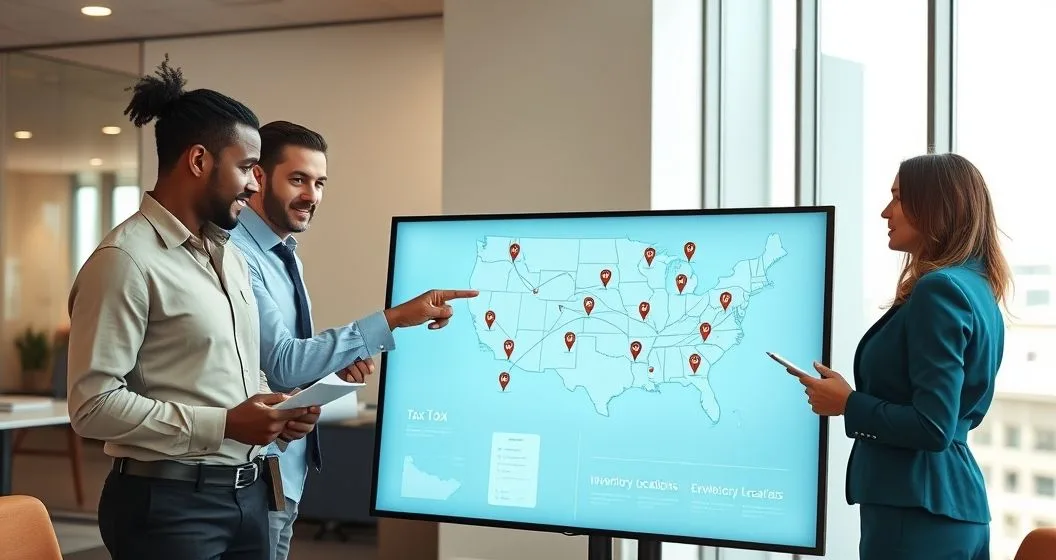Background and legal turning point
The modern remote-seller nexus framework grew out of the U.S. Supreme Court’s decision in South Dakota v. Wayfair, Inc. (2018), which allowed states to require out-of-state sellers to collect sales tax based on economic activity rather than physical presence. After Wayfair many states enacted or updated economic-nexus rules (commonly thresholds like $100,000 in sales or 200 transactions, though amounts vary by state). Always confirm the exact standard with each state’s Department of Revenue or official guidance.
How nexus is commonly established (practical tests)
- Physical presence: Any physical location in the state—an office, retail location, warehouse, fulfillment center (including third‑party warehouses used for fulfillment)—can create nexus. Using third‑party logistics (e.g., FBA inventory) commonly triggers nexus.
- Economic nexus: States set sales- or transaction-based thresholds that, once exceeded, require registration and collection. Many states use a $100,000/200-transactions model, but some use different sales thresholds or only sales dollar amounts.
- Marketplace-facilitator rules: Many states now require marketplaces (Amazon, Etsy, etc.) to collect and remit tax on behalf of sellers. That shifts the compliance burden for marketplace sellers in many cases, but sellers should confirm marketplace rules and look for reporting obligations.
- Affiliate, click-through, and agent tests: You can acquire nexus if related entities, affiliates, or independent agents in a state refer customers or create a presence that links back to you.
- Employees and contractors: Sales, installations, demos, or even short-term travel by employees or contractors into a state can create a taxable presence.
Real-world example
An online furniture seller based in California stores inventory in a Texas fulfillment center. That storage is a physical presence in Texas and will typically create nexus there, requiring the seller to register for a Texas sales tax permit, collect Texas sales tax on taxable sales, and file returns. This is a common trap for businesses using national fulfillment networks.
Who is affected
All remote sellers who make sales into multiple states should review nexus: e-commerce retailers, dropshippers, SaaS providers (taxability varies by state), subscription services, and marketplace sellers. Startups and small businesses often underestimate nexus risk when they scale or use third‑party warehouses.
Practical steps to identify and manage nexus (professional strategies)
- Run a nexus assessment quarterly. Track sales by state, transaction counts, inventory locations, employees, and referral relationships.
- Use automation. Sales-tax engines (Avalara, TaxJar, Sovos and others) can track thresholds, calculate taxability and help file returns. Integrate one with your checkout and accounting systems.
- Register proactively. If you cross a threshold, register for a sales tax permit promptly to avoid penalties.
- Consider voluntary disclosure agreements (VDAs). If you discover past uncollected tax, many states offer programs that limit look-back periods and penalties when you come forward voluntarily—ask a tax advisor.
- Maintain documentation. Keep shipping records, warehouse agreements, marketplace statements, and contractor logs to support nexus positions in an audit.
Common mistakes and misconceptions
- “Online-only” equals tax-free: False. Wayfair enables states to tax based on economic activity even without any physical presence.
- Ignoring marketplace rules: Marketplaces often collect tax, but sellers may still have registration or reporting duties depending on state law.
- Treating thresholds as uniform: Thresholds differ by state and change over time—don’t assume a universal $100k/200-tx rule.
Short checklist to start (first 30–90 days)
- Map where you sell: total sales and transaction counts by state for the last 12 months.
- Identify inventory and fulfillment locations, including third‑party warehouses.
- Review marketplace facilitator and third‑party platform reporting.
- Engage a CPA or multistate sales tax specialist if your footprint crosses multiple states.
FAQs (brief)
- Do I need to register in every state where I have customers? Only if you have nexus in that state (physical, economic, or other statutory triggers). Check state rules for specific thresholds.
- What if I failed to collect sales tax? States can assess back taxes, interest, and penalties. VDAs may reduce exposure in many states—contact a tax professional.
- Are digital goods and SaaS taxed the same everywhere? No. Taxability of digital products and services varies by state; check state guidance or see our article on State Sales Tax Nexus for Remote SaaS Companies in 2025.
Interlinking resources on FinHelp
- For marketplace-specific rules and seller traps, see: Avoiding Sales Tax Nexus Traps for Digital Products and Subscriptions.
- If you’re expanding, our guide on registrations may help: How to Register for State Sales Tax When Expanding an Online Business.
Authoritative sources and where to confirm state rules
- South Dakota v. Wayfair, Inc., 138 S. Ct. 2080 (2018).
- Check each state’s Department of Revenue website for current thresholds and guidance. For federal perspective and small‑business resources, see the IRS Small Business pages (https://www.irs.gov).
- Consumer Financial Protection Bureau general consumer resources: https://www.consumerfinance.gov/.
Professional disclaimer
This content is educational and does not replace personalized tax advice. Nexus analysis is fact-specific and state rules change; consult a licensed CPA or state tax specialist before making compliance decisions.
(Updated 2025)



